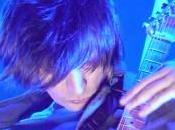

It is the most active volcano in the country. Just northeast of Bagana is the volcano crater lake Billy Mitchell (see other picture). Bagana is one of 17 post-Miocene stratovolcanos on Bougainville. U.S. General Floyd L. Parks flew over the Solomon Islands on 27 October 1948 and witnessed the eruption of Bagana. His photographs of Bagana erupting were published in Life magazine.
Bagana volcano, occupying a remote portion of central Bougainville Island, is one of Melanesia’s youngest and most active volcanoes. Bagana is a massive symmetrical, roughly 1750-m-high lava cone largely constructed by an accumulation of viscous andesitic lava flows. The entire lava cone could have been constructed in about 300 years at its present rate of lava production. Eruptive activity at Bagana is frequent and is characterized by non-explosive effusion of viscous lava that maintains a small lava dome in the summit crater, although explosive activity occasionally producing pyroclastic flows also occurs. Lava flows form dramatic, freshly preserved tongue-shaped lobes up to 50-m-thick with prominent levees that descend the volcano’s flanks on all sides.
Eruptions ( based on data of volcanodiscovery.com )
2008-12 activity
Bagana continues to erupt small ash explosions from time to time, producing ash plumes that rise to 2.4-3 km altitude and are monitored by the Darwin VAAC.
2008 earthquake
A magnitude 6.2 earthquake occurred 38 km SW of Bagana volcano on Tuesday 23 December 2008.
2007-08 eruptions
Lava flows, ash explosions and pyroclastic flows occurred at Bagana volcano between June 2007 and March 2008. On 12 June 2007, a strong ash emission was noted and glow was visible in the night of 14 June. This activity continued into July.
On 14 July, Bagana generated a powerful explosion that generated a pyroclastic flow, which descended the S flank and stopped at the base near a small hot-spring-fed lake located at the head of the Torokina river.
On 6 August, the lava flow from the summit crater on the SE flank became active again and continued through 23 August. Continuous incandescence was visible down the SE flank during 6-10 August.
The activity was occasionally accompanied by ash plumes generated by rockfalls from lava-flow edges. Darwin VAAC reported that a diffuse plume at an altitude of 3.7 km (12,000 ft) a.s.l. on 23 August.




2004 eruptions
In April and May 2004, Bagana produced lava flows which traveled 3 km from the summit and came within 3 km of some villages.
1966 eruption
A large ash eruption occurred on 30 May 1966 and generated pyroclastic flows.
1962 eruption
Bagana’s activity increased in early 1962 and culminated in a major strombolian-type eruption on 15 February. Lava bursts followed at intervals of 5-10 minutes. Earthquakes and ash emissions continued until April.
1950 eruption
The first time pyroclastic flows were reported from remote Bagana volcano was in 1950, when the summit contained a lava dome, which generated pyroclastic flows by partial collapse. Violent explosions occurred between June and October 1950 and were accompanied by intense earthquakes and loud ash explosions generating ash plumes rising to up to 3-4 km altitude.
1943 effusive eruption
A new lava flow appeared on the NNE flank of Bagana volcano in late March or early April 1943, as aerial photos taken between 18 February and 7 April showed.
1937 eruption
The sound of a loud explosion from Bagana was heard in Kieta village 50 km away in September 1937, when a new eruption began at Bagana. The The Sydney Morning Herald reported on 9 September:
“A violent volcanic eruption began on Tuesday morning at Mt. Bagana, near Kieta, on the island of Bougainville, 250 miles south-east of Rabaul. Columns of smoke rose more than 15,000 feet.
There is no danger to the township of Kieta but the area near the mountain is thickly populated by natives.”
1875 eruption
Dense steam and ash clouds were observed at Bagana volcano from the German ship SMS Gazelle on 25 August 1875.
Earthquakes
The list below shows the earthquake activity in a narrow radius around the volcano. Unfortunately we are only able to report the stronger earthquakes reported by the most important seismological agencies in the world. Our earthquakes database began registering early 2012.

SRC Location UTC Date/time M D INFORMATION
ER Seismicity Startup Record Jan 01 00:00 AM 0.1 0.1 MAP
Enter Email (not compulsory)
Your current location
MMI II (Very weak shaking)
?
People :
Felt by persons at rest, on upper floors or favorably placed.
MMI III (Weak shaking)
?
People :
Felt indoors; hanging objects may swing, vibration similar to passing of light trucks, duration may be estimated, may not be recognized as an earthquake.
MMI IV (Light shaking)
?
People :
Generally noticed indoors but not outside. Light sleepers may be awakened. Vibration may be likened to the passing of heavy traffic, or to the jolt of a heavy object falling or striking the building.
Fittings :
Doors and windows rattle. Glassware and crockery rattle. Liquids in open vessels may be slightly disturbed. Standing motorcars may rock.
Structures :
Walls and frames of buildings, and partitions and suspended ceilings in commercial buildings, may be heard to creak.
MMI V (Moderate shaking)
?
People :
Generally felt outside, and by almost everyone indoors. Most sleepers awakened. A few people alarmed.
Fittings :
Small unstable objects are displaced or upset. Some glassware and crockery may be broken. Hanging pictures knock against the wall. Open doors may swing. Cupboard doors secured by magnetic catches may open. Pendulum clocks stop, start, or change rate.
Structures :
Some large display windows cracked. A few earthenware toilet fixtures cracked.
MMI VI (Strong shaking)
?
People
Felt by all. People and animals alarmed. Many run outside. Difficulty experienced in walking steadily.
Fittings :
Objects fall from shelves. Pictures fall from walls. Some furniture moved on smooth floors, some unsecured free-standing fireplaces moved. Glassware and crockery broken. Very unstable furniture overturned. Small church and school bells ring. Appliances move on bench or table tops. Filing cabinets or “easy glide” drawers may open (or shut).
Structures :
Slight damage to buildings with low standard. Some stucco or cement plaster falls. Large display windows broken. Damage to a few weak domestic chimneys, some may fall.
Environment :
Trees and bushes shake, or are heard to rustle. Loose material may be dislodged from sloping ground, e.g. existing slides, talus slopes, shingle slides.
MMI VII (Very strong shaking)
?
People
General alarm. Difficulty experienced in standing. Noticed by motorcar drivers who may stop.
Fittings :
Large bells ring. Furniture moves on smooth floors, may move on carpeted floors. Substantial damage to fragile contents of buildings.
Structures :
Unreinforced stone and brick walls cracked. Low standard buildings cracked with some minor masonry falls. A few instances of damage to buildings of ordinary workmanship. Unbraced parapets, unbraced brick gables, and architectural ornaments fall. Roofing tiles, especially ridge tiles may be dislodged. Many unreinforced domestic chimneys damaged, often falling from roof-line. Water tanks Type I burst. A few instances of damage to brick veneers and plaster or cement-based linings. Unrestrained water cylinders (hot-water cylinders) may move and leak. Some common windows cracked. Suspended ceilings damaged.
Environment :
Water made turbid by stirred up mud. Small slides such as falls of sand and gravel banks, and small rock-falls from steep slopes and cuttings. Instances of settlement of unconsolidated or wet, or weak soils. Some fine cracks appear in sloping ground. A few instances of liquefaction (i.e. small water and sand ejections).
MMI VIII (Severe shaking)
?
People
Alarm may approach panic. Steering of motorcars greatly affected.
Structures :
Low standard buildings heavily damaged, some collapse. ordinary workmanship buildings damaged, some with partial collapse. Reinforced masonry or concrete buildings damaged in some cases. A few instances of damage to buildings and bridges designed and built to resist earthquakes. Monuments and pre-1976 elevated tanks and factory stacks twisted or brought down. Some pre-1965 infill masonry panels damaged. A few post-1980 brick veneers damaged. Decayed timber piles of houses damaged. Houses not secured to foundations may move. Most unreinforced domestic chimneys damaged, some below roof-line, many brought down.
Environment :
Cracks appear on steep slopes and in wet ground. Small to moderate slides in roadside cuttings and unsupported excavations. Small water and sand ejections and localized lateral spreading adjacent to streams, canals, lakes, etc.
MMI IX (Violent shaking)
?
Structures
Many low standard buildings destroyed. Ordinary workmanship buildings heavily damaged, some collapse. Reinforced masonry or concrete buildings damaged, some with partial collapse. Buildings and bridges designed and built to resist earthquakes damaged in some cases, some with flexible frames seriously damaged. Damage or permanent distortion to some buildings and bridges, designed and built to normal use standards. Houses not secured to foundations shifted off. Brick veneers fall and expose frames.
Environment :
Cracking of ground conspicuous. Landsliding general on steep slopes. Liquefaction effects intensified and more widespread, with large lateral spreading and flow sliding adjacent to streams, canals, lakes, etc.
Write your experience and/or additional text here (max. 500 characters)




